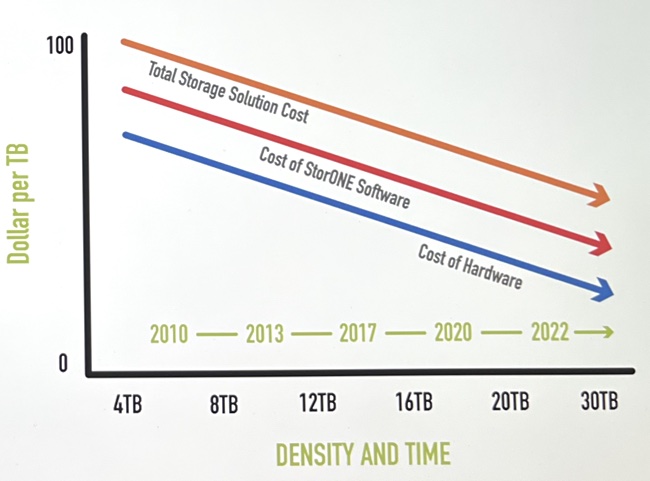StorONE has introduced a per-drive pricing model and updated its Storage Engine software to deliver more IOPS from fewer drives, automatically tier from SSDs to disk drives with no performance drops, and rebuild failed disks faster than before.
StorONE’s clusterable storage software provides virtual storage containers with block, file or object storage, and can deliver 500,000 IOPS from a commodity server with six SSDs. The drive count based pricing model, called Scale-for-free, means customers no longer pay on a capacity basis and can scale up to higher drive capacities at no charge.
StorONE CMO George Crump said: “It’s almost as if the customer is punished for going to higher capacity drives.” He pointed out that Oracle database software is not priced on a capacity basis – on the number of rows in a database, for example. Instead it-s priced on a per-server processor core basis. Storage software should similarly break the pricing link with capacity.
We know that the $/TB cost of drives declines over time. Yet storage system prices don’t decline as fast. Omdia analyst Roy Illsley tweeted: “An [interesting] bit of data I have found when doing some preliminary analysis of our data sets: the unit price of storage has remained fairly consistent over the past 12 years. [Yet] the technology has changed and capacity has increased.”
A StorONE chart shows this pattern with an indicative $/TB vs density over time plot:

StorONE says its pricing model changes things so that the $/TB cost of storage software goes down over time in lockstep with storage drive hardware costs:

In the StorONe scheme there are two basic charging levels: price per HDD and price per SSD. Both are charged as $/month over a 1- to 3-year term, and with a minimum fee. If its software runs in the public cloud, then charging is based on the number of VM instances required, as the actual number of physical drives used in the public cloud is not readily visible.
Customers get predictable pricing and can scale up drive capacity with no extra software charge. Sample prices were not provided, however StorONE did say other (legacy) storage systems would need 36x 7.68TB SSDs to deliver 500,000 IOPs and that would cost $84,600 @ $2,350/drive plus the cost of the storage chassis. Its media cost for a 500,000 IOPS system would be $27,900 based on 6x 15.TB drives @ $4,650/drive and have a lower storage chassis cost as well.
The per-drive pricing scheme looks interesting, but we would need actual prices to make comparisons with other vendors with capacity-based pricing. Back in May 2020 there was a publicly accessible StorONE online configurator with openly available pricing. That’s gone away – replaced with a fireside chat video, a downloadable but pretty slim ESG white paper, and a claim that StorONe can be half the price of competing storage systems. No actual prices though.
Rebuilds, tiering and scaling
The risk of using high-capacity drives is that drive rebuild times after a failure can be high – more than 24 hours in the case of a 20TB disk drive. StorONE’s erasure code-based vRAID process has always rebuilt drives fast – in October 2020 it could rebuild a 16TB disk drive in under five hours. The erasure code software has been re-written and a 20TB drive can now be rebuilt in under three hours. SSD rebuilds take single-digit minutes, as before.
StorONE says its new SSD to HDD auto-tiering software pre-emptively writes older data from SSD to HDDs when there is a slow down in IO activity, so that whenever fresh data comes into the system there is space in the SSD tier to receive it with more consistent performance as a result.
The Storage Engine’s metadata management software has also been rewritten so that less memory capacity is needed to store the mapping data as the system’s capacity scales out to a 20PB clusters. Whereas 512GB of DRAM would have been needed for a 15PB StorONE system, that same 512GB can now be used for a 20PB system. StorONE says competing systems will need more than a terabyte of memory to support 20PB of storage capacity – no named examples have been provided.
This comprehensive update also adds:
- An HTML5 GUI interface to allow control of the StorONE engine from any location and almost any device;
- RESTful API support for automation and integration of StorONE into existing operations consoles;
- System telemetry analysis, such as abnormal drive pool capacity changes, to detect ransomware attacks and alert admin staff (snapshots down to 30 second granularity enable precise rollback to a pre-attack state),
- Two-factor user authentication;
- Encryption scope flexibility with encryption per volume, per application (VMware, Oracle, etc.) or, via self-encrypting drives, per drive.
Bootnote
US-headquartered StorONE was founded in 2011 in Israel by CEO Gal Naor and CTO Raz Gordon. Gordon is currently auditing at EY. It raised $30 million in a single funding round in 2012, developed its enterprise-class TRU S1 storage engine software over seven years, announced it in 2018 and has had no subsequent funding rounds, making it quite unusual in the funding regard. The software is said to be faster than traditional storage software, and is sold through a global network of partners.








